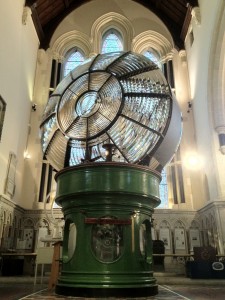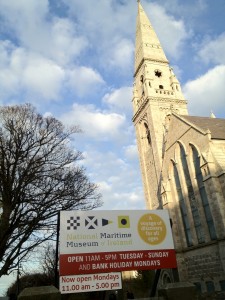
This year is the 1550th anniversary of King Laoghaire. Since his reign was the start of literacy and the dawn of Irish recorded history, we thought we would send our resident correspondent Jason McDonnell out to visit one of Dun Laoghaire’s tourist hot spots, the Maritime Museum, which was re-opened by their patron President Michael D Higgins in 2012.
I met with John Paul Durcan, one of the directors at the Old Mariners’ Church on Haigh Terrace recently and he told me about the unique Mariners’ Church and how it was built specifically for sea farers in 1830. At the time, Ireland was under the thumb of the British Empire and the church was used by the British Navy. An organisation called The Maritime Institute of Ireland was founded in 1944 to advise the government on sea faring historical facts, and to represent sea farers. This was the only voice for sea farers in Ireland at the time unlike now where there are lots of organisations representing them.
The Maritime Institute of Ireland still exists in name and it is that institute who own and run the museum. It is a voluntary organisation and in the early 70s the church authorities gave the institute the building to act as a museum. The early committee filled it with artefacts but it fell into disrepair due to lack of funds. The church itself had various issues relating to leakages and general wear and tear but fortunately around eight years ago they sought government funding to restore the church and prepare it for the future so it could continue to be a museum.
They were given 3.5 million euros in grant aid over different allotments. Most of the money was put into the restoration of the church, for example; sand blasting, pointing and also the roof work inside and outside with all inside walls having to be replastered also. Due to the fact that it was a historical building, it had to be restored using the same original methods, which was quite expensive.
 They later put in for more money for further fittings and fixtures that would bring it up to the specifications simular to that of Collinsí Barracks but unfortunately that did not happen as government money had run out. So they are really beholden to the services of the community and the people Ireland who come and supported the museum. Their contribution of 5 euros (3 euros for the unwaged) as they enter the building goes towards the upkeep of the church and museum.
They later put in for more money for further fittings and fixtures that would bring it up to the specifications simular to that of Collinsí Barracks but unfortunately that did not happen as government money had run out. So they are really beholden to the services of the community and the people Ireland who come and supported the museum. Their contribution of 5 euros (3 euros for the unwaged) as they enter the building goes towards the upkeep of the church and museum.
The building holds a number of artefacts which are of significant importance. Thereís a display of documents and items belonging to Captain Halpin, commander of the Great Eastern, the largest ship in the world. It was built in 1857 and a clockwork model of the ship there is over one hundred years old.
A working optic from the Baily Lighthouse in Howth, North Dublin is also on display. It was installed in 1902 and removed in 1972 when the lighthouse was modernised. Originally gas, then oil powered, the light now shines a lesser light over the museum.
There’s a naval display tracing the history of the Irish naval service from before independence to the present day, those displays include models, photos, documents and uniforms connected with the history of the Naval Force.
My personal favourite is a rare artefact from the Titanic, a light bulb that was taken from her before she sailed out to sea from Belfast which was kept in the custody of the electrician who had replaced it before she set sail. Most museums only have Titanic artefacts which were recovered from the seabed.
They also have the Lloyd’s register of ships. Llyod’s of London were the insurance company that insured shipping back in 1912 and of course in that is the register of the sinking of the Titanic.
A display dedicated to the sinking of the RMS Leinster, which was sunk in October 1918 and was used to deliver the mail by An Post is also available. There were around a thousand workers on board, most of them from Dun Laoghaire and Holyhead, when in 1918 the Germans got word that the boat was also being used by some British soldiers as they returned to the Western Front in France, making it a legitimate target. They fired two torpedos from the German U Boat 123 into it on the morning of 10th of October as it left Dun Laoghaire. She sunk outside the Harbour and 535 lives were lost.
John Paul Durcan would also like to make an appeal for volunteers as the museum is run by them.
By Jason McDonnell



